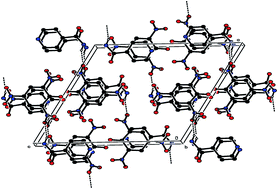A new organic NLO material isonicotinamidium picrate (ISPA): crystal structure, structural modeling and its physico-chemical properties†
Abstract
A novel organic nonlinear optical (NLO) crystal, isonicotinamidium picrate (ISPA) was synthesized and grown by the slow evaporation method. Formation of the new crystalline compound was confirmed by a single crystal X-ray diffraction study. The title compound crystallizes in the monoclinic crystal system with the space group of P21/n. DFT was carried out to calculate the bond lengths and bond angles. Structural parameters obtained from single crystal XRD and DFT studies are in good agreement with each other. The frontier energy gaps calculated theoretically are useful to understand the charge transfer taking place in the molecule. Polarizability of the ISPA compound is found using Penn gap analysis and the Clausius–Mossotti equation. The UV-vis-NIR spectral study showed that the grown crystal is transparent in the entire visible region with the lower cut-off wavelength of 469 nm. The four independent tensor coefficients of dielectric permittivity were found to be ε11 = 1.42, ε22 = 4.62, ε33 = 6.23 and ε13 = 5.56 from the dielectric measurements. The titular compound ISPA is thermally stable up to 229 °C assessed by thermogravimetric and differential thermal (TG-DTA) analyses. The specific heat capacity of ISPA is found to be 3.49 J g−1 K−1. The laser induced surface damage threshold of the grown crystal was measured to be 0.22537 GW cm−2 for 1064 nm Nd:YAG laser radiation. Nonlinear refractive index (n2), absorption coefficient (β) and third order nonlinear susceptibility (χ(3)) were determined using the Z-scan technique. The optical limiting study revealed that the transmitted output power increases linearly with the input power up to the irradiance of around 3.25 mW mm−2.


 Please wait while we load your content...
Please wait while we load your content...